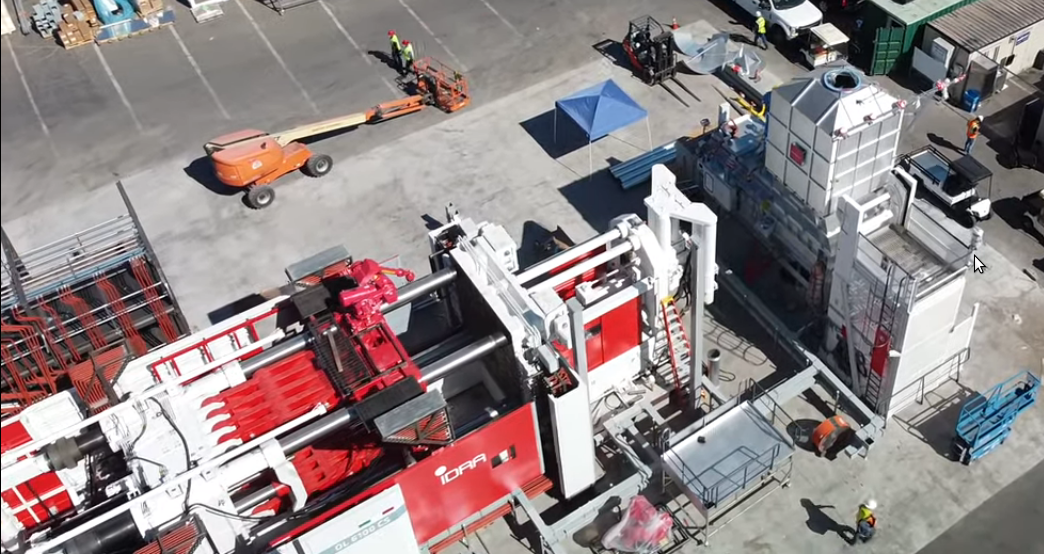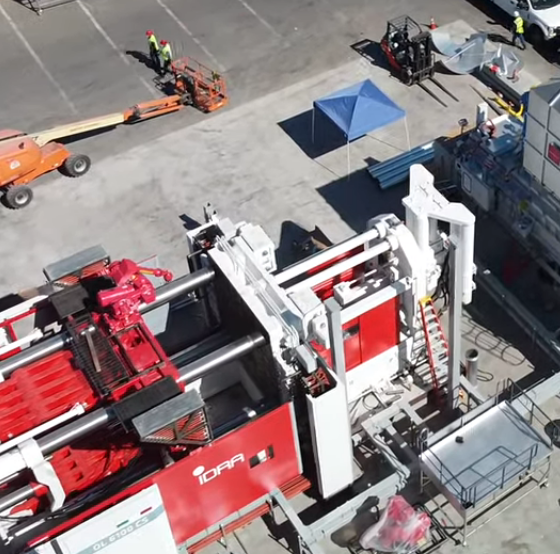

News
JP Morgan admits Tesla’s Giga Press advantage, but posts strangely low output estimate
The advantages of Tesla’s Giga Press machines have been acknowledged by JP Morgan in a recent analysis, with the Wall St firm noting that the massive contraptions could very well be a game-changer for the electric car maker. However, amidst the firm’s optimism, JP Morgan’s analysis did feature something quite strange, particularly on estimates about the Giga Press’ annual output.
JP Morgan noted that it visited LK Tech, the largest die casting machine supplier in the market, for its analysis. The firm stated that it was able to meet the Founder and CEO of LK Tech and the Head of IDRA, the company’s Italian subsidiary that has so far provided Giga Presses in the Fremont Factory, Giga Berlin, and Giga Texas. Tesla’s Giga Shanghai has been spotted with Giga Presses that are branded with LK Tech.
JPMorgan analyses Tesla’s Giga Press 👇🏻$TSLA pic.twitter.com/cwc4eAzoMJ
— David Tayar (@davidtayar5) February 11, 2021
The Wall Street firm’s analysis showcased several insights that have been discussed by industry experts such as Sandy Munro in the past, such as the Giga Press’ capability to simplify Tesla’s vehicle assembly process by replacing 70 pieces of metal into a single-piece megacast. JP Morgan also acknowledged that with the Giga Press, Tesla could adopt a lightweight, cost-efficient, and more straightforward production process, giving it an edge against its competitors in the auto segment.
Things become more interesting when JP Morgan shared its estimates on the Giga Press’ output, however. In a section listed as “The Maths,” the Wall Street firm assumed that each Giga Press would be capable of producing one part every 4-5 minutes, or about 240-300 seconds. At this rate, the firm estimated that one Giga Press would have an annual output of 70-90k units, which meant that Tesla would need about 8-10 Giga Presses to manufacture 350k Model Y per year.
“Assuming the casting machine produces one body part every 4-5 mins, around 70-90k units of annual production can be generated from one Giga Press. Given two Giga Presses are needed for each Model Y (one front ad one rear body part), it is estimated that around 8-10 Giga Presses are needed for the production of 350k units of Model Y,” JP Morgan wrote.
This estimate is notably lower than what has been expected by the electric vehicle community, mainly since Die-Casting Machine #1 (DCM1), which was recently deployed in the Fremont Factory, has already been observed to have a cycle time of about 170-200 seconds as per drone videos of the contraption. This is already quicker than JP Morgan’s estimates, and this is also with the machine’s operations still being optimized.
Specifications of the Giga Press from IDRA also indicate that the machines could have a cycle time of ~80-90 seconds, allowing an output of 40-45 castings per hour or about 1,000 castings per day. Considering that Tesla is still in the process of mastering its house-sized machines, there seems to be a good chance that the electric car maker could produce 350k Model Y in one year using far less than 8-10 Giga Presses.
Check out DCM1’s operations as of late January in the video below.
Don’t hesitate to contact us for news tips. Just send a message to tips@teslarati.com to give us a heads up.

News
Tesla is not sparing any expense in ensuring the Cybercab is safe
Images shared by the longtime watcher showed 16 Cybercab prototypes parked near Giga Texas’ dedicated crash test facility.

The Tesla Cybercab could very well be the safest taxi on the road when it is released and deployed for public use. This was, at least, hinted at by the intensive safety tests that Tesla seems to be putting the autonomous two-seater through at its Giga Texas crash test facility.
Intensive crash tests
As per recent images from longtime Giga Texas watcher and drone operator Joe Tegtmeyer, Tesla seems to be very busy crash testing Cybercab units. Images shared by the longtime watcher showed 16 Cybercab prototypes parked near Giga Texas’ dedicated crash test facility just before the holidays.
Tegtmeyer’s aerial photos showed the prototypes clustered outside the factory’s testing building. Some uncovered Cybercabs showed notable damage and one even had its airbags engaged. With Cybercab production expected to start in about 130 days, it appears that Tesla is very busy ensuring that its autonomous two-seater ends up becoming the safest taxi on public roads.
Prioritizing safety
With no human driver controls, the Cybercab demands exceptional active and passive safety systems to protect occupants in any scenario. Considering Tesla’s reputation, it is then understandable that the company seems to be sparing no expense in ensuring that the Cybercab is as safe as possible.
Tesla’s focus on safety was recently highlighted when the Cybertruck achieved a Top Safety Pick+ rating from the Insurance Institute for Highway Safety (IIHS). This was a notable victory for the Cybertruck as critics have long claimed that the vehicle will be one of, if not the, most unsafe truck on the road due to its appearance. The vehicle’s Top Safety Pick+ rating, if any, simply proved that Tesla never neglects to make its cars as safe as possible, and that definitely includes the Cybercab.
Elon Musk
Tesla’s Elon Musk gives timeframe for FSD’s release in UAE
Provided that Musk’s timeframe proves accurate, FSD would be able to start saturating the Middle East, starting with the UAE, next year.

Tesla CEO Elon Musk stated on Monday that Full Self-Driving (Supervised) could launch in the United Arab Emirates (UAE) as soon as January 2026.
Provided that Musk’s timeframe proves accurate, FSD would be able to start saturating the Middle East, starting with the UAE, next year.
Musk’s estimate
In a post on X, UAE-based political analyst Ahmed Sharif Al Amiri asked Musk when FSD would arrive in the country, quoting an earlier post where the CEO encouraged users to try out FSD for themselves. Musk responded directly to the analyst’s inquiry.
“Hopefully, next month,” Musk wrote. The exchange attracted a lot of attention, with numerous X users sharing their excitement at the idea of FSD being brought to a new country. FSD (Supervised), after all, would likely allow hands-off highway driving, urban navigation, and parking under driver oversight in traffic-heavy cities such as Dubai and Abu Dhabi.
Musk’s comments about FSD’s arrival in the UAE were posted following his visit to the Middle Eastern country. Over the weekend, images were shared online of Musk meeting with UAE Defense Minister, Deputy Prime Minister, and Dubai Crown Prince HH Sheikh Hamdan bin Mohammed. Musk also posted a supportive message about the country, posting “UAE rocks!” on X.
FSD recognition
FSD has been getting quite a lot of support from foreign media outlets. FSD (Supervised) earned high marks from Germany’s largest car magazine, Auto Bild, during a test in Berlin’s challenging urban environment. The demonstration highlighted the system’s ability to handle dense traffic, construction sites, pedestrian crossings, and narrow streets with smooth, confident decision-making.
Journalist Robin Hornig was particularly struck by FSD’s superior perception and tireless attention, stating: “Tesla FSD Supervised sees more than I do. It doesn’t get distracted and never gets tired. I like to think I’m a good driver, but I can’t match this system’s all-around vision. It’s at its best when both work together: my experience and the Tesla’s constant attention.” Only one intervention was needed when the system misread a route, showcasing its maturity while relying on vision-only sensors and over-the-air learning.
News
Tesla quietly flexes FSD’s reliability amid Waymo blackout in San Francisco
“Tesla Robotaxis were unaffected by the SF power outage,” Musk wrote in his post.

Tesla highlighted its Full Self-Driving (Supervised) system’s robustness this week by sharing dashcam footage of a vehicle in FSD navigating pitch-black San Francisco streets during the city’s widespread power outage.
While Waymo’s robotaxis stalled and caused traffic jams, Tesla’s vision-only approach kept operating seamlessly without remote intervention. Elon Musk amplified the clip, highlighting the contrast between the two systems.
Tesla FSD handles total darkness
The @Tesla_AI account posted a video from a Model Y operating on FSD during San Francisco’s blackout. As could be seen in the video, streetlights, traffic signals, and surrounding illumination were completely out, but the vehicle drove confidently and cautiously, just like a proficient human driver.
Musk reposted the clip, adding context to reports of Waymo vehicles struggling in the same conditions. “Tesla Robotaxis were unaffected by the SF power outage,” Musk wrote in his post.
Musk and the Tesla AI team’s posts highlight the idea that FSD operates a lot like any experienced human driver. Since the system does not rely on a variety of sensors and a complicated symphony of factors, vehicles could technically navigate challenging circumstances as they emerge. This definitely seemed to be the case in San Francisco.
Waymo’s blackout struggles
Waymo faced scrutiny after multiple self-driving Jaguar I-PACE taxis stopped functioning during the blackout, blocking lanes, causing traffic jams, and requiring manual retrieval. Videos shared during the power outage showed fleets of Waymo vehicles just stopping in the middle of the road, seemingly confused about what to do when the lights go out.
In a comment, Waymo stated that its vehicles treat nonfunctional signals as four-way stops, but “the sheer scale of the outage led to instances where vehicles remained stationary longer than usual to confirm the state of the affected intersections. This contributed to traffic friction during the height of the congestion.”
A company spokesperson also shared some thoughts about the incidents. “Yesterday’s power outage was a widespread event that caused gridlock across San Francisco, with non-functioning traffic signals and transit disruptions. While the failure of the utility infrastructure was significant, we are committed to ensuring our technology adjusts to traffic flow during such events,” the Waymo spokesperson stated, adding that it is “focused on rapidly integrating the lessons learned from this event, and are committed to earning and maintaining the trust of the communities we serve every day.”








